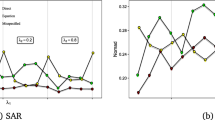Abstract
The focus of this paper is on spatial structural equation models (S-SEM) also extended to a Panel data framework. More specifically, our objective is to introduce a generalized maximum entropy formulation for the class of S-SEM with the aim of developing a composite index. We present an application of the method to real data finalized to investigate dynamics and complex interactions between some selected dimensions that represent the main measures of intangible assets for a panel of OECD countries over the period 1998–2008.

Similar content being viewed by others
Notes
Other spatial model specifications with lagged terms for all dimensions are also used to check the robustness of the Lag- Model including only the spatial innovation component.
Sweden, Finland, Denmark, Norway, Iceland, Netherlands, Belgium, Switzerland, United Kingdom, Germany, Ireland, France, Austria, Spain, Slovenia, Greece, Italy, Portugal, Hungary, Poland, Czech Republic, Estonia, Lithuania, Latvia, Turkey, Bulgaria, Romania.
Source: World Bank, OECD, USPTO.
Source: UNESCO, World Bank.
Source: World values Survey.
References
Anselin, L.: Spatial Econometrics: methods and models, vol. 4. Springer, Berlin (1988)
Baltagi, B.H.: A Companion to Theoretical Econometrics. Wiley, New York (2008)
Bernardini Papalia, R.: Modeling mixed spatial processes and spatio-temporal dynamics in information-theoretic frameworks. In: Rizzi, M., Vichi, A. (eds.) COMPSTAT 2006. Springer, Heidelberg (2006)
Bernardini Papalia, R.: Analyzing trade dynamics from incomplete data in spatial regional models: a maximum entropy approach. In: De Souza Lauretto, S.J., Braganca Pereira, C.A. (eds.) AIP Conference Proceedings, vol. 1073, pp. 325–331. American Institute of Physics, Melville (2008)
Bernardini Papalia, R.: A composite generalized cross-entropy formulation in small samples estimation. Econom. Rev. 27(4–6), 596–609 (2008)
Bernardini Papalia, R., Ciavolino, E.: Gme estimation of spatial structural equations models. J. Classif. 28(1), 126–141 (2011)
Bollen, K.A.: Structural equation models. Wiley Online Library (1998)
Ciavolino, E.: General distress as second-order latent variable estimated through PLS-PM approach. Electron. J. Appl. Stat. Anal. 5(3), 458–464 (2012)
Ciavolino, E., Al-Nasser, A.D.: Comparing generalised maximum entropy and partial least squares methods for structural equation models. J. Nonparametric Stat. 21(8), 1017–1036 (2009)
Ciavolino, E., Nitti, M.: Simulation study for PLS path modelling with high-order construct: A job satisfaction model evidence. In: Proto, A.N., Squillante, M., Kacprzyk, J. (eds.) Advanced Dynamic Modeling of Economic and Social Systems, pp. 185–207. Springer, Berlin/ Heidelberg (2013)
Ciavolino, E., Nitti, M.: Using the Hybrid Two-Step estimation approach for the identification of second-order latent variable models. J. Appl. Stat. 40(3), 508–526 (2013)
Elhorst, J.: Spatial panel data models, chapter 2. In: Fischer M.M., Getis A. (eds.) Handbook of Applied Spatial Analysis, pp. 377–405. Springer, Berlin (2010)
Elhorst, J.P.: Specification and estimation of spatial panel data models. Int. Reg. Sci. Rev 26(3), 244–268 (2003)
Joreskog, K.: A general method of estimating a linear structural equation system. In: Goldberg, D., Duncan, S.A. (eds.) Structural Equation Models in the Social Sciences. Seminar Press, New York (1973)
Kapoor, M., Kelejian, H.H., Prucha, I.R.: Panel data models with spatially correlated error components. J. Econom. 140(1), 97–130 (2007)
Kelejian, H.H., Prucha, I.R.: A generalized spatial two-stage least squares procedure for estimating a spatial autoregressive model with autoregressive disturbances. J. Real Estate Financ. Econ. 17(1), 99–121 (1998)
LeSage, J., Pace, R.K.: Introduction to Spatial Econometrics. CRC Press, Boca Raton (2008)
LeSage, J.P., Pace, R.K.: Spatial and Spatiotemporal Econometrics. Elsevier JAI, Amsterdam (2004)
Pukelsheim, F.: The three sigma rule. Am. Stat. 48(2), 88–91 (1994)
Author information
Authors and Affiliations
Corresponding author
Rights and permissions
About this article
Cite this article
Bernardini Papalia, R., Ciavolino, E. Developing a composite index by using spatial latent modelling based on information theoretic estimation. Qual Quant 49, 989–997 (2015). https://doi.org/10.1007/s11135-014-0159-8
Published:
Issue Date:
DOI: https://doi.org/10.1007/s11135-014-0159-8




